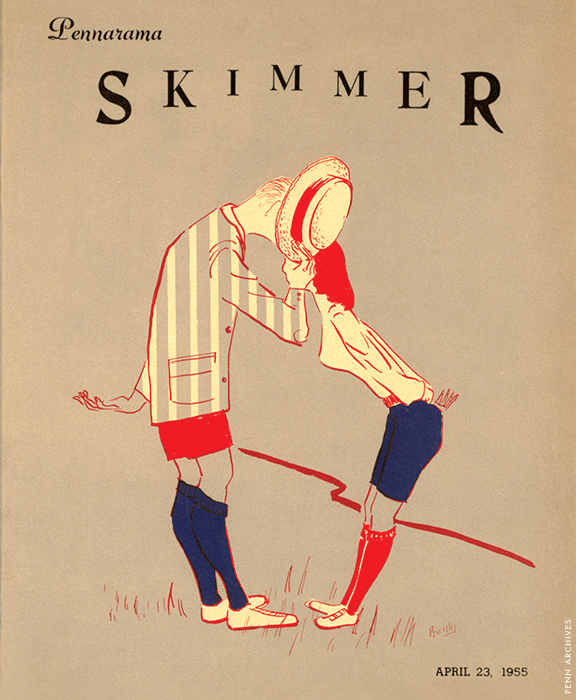
Looking back at the (r)evolution of spring festivals at Penn.
BY VIOLET BARON
Skimmer cover from Penn Archives
Additional Illustration by Josh Cochran
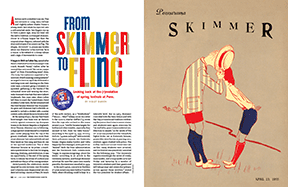
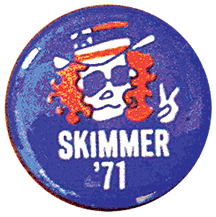
A button can be a window to an era. This one certainly is. Long, wavy red hair and slightly askew shades frame a young man’s face while his lips curl into a self-satisfied smile. Two fingers rise up to form a peace sign. Atop his head sits the nod to tradition: a revamped skimmer, closer to a floppy hippie hat than the original straw chapeau, adorned with the stars and stripes of an American flag. The slogan, SKIMMER ’71, erases any doubts about our character or his motives: he is a teaser, a throwback to a dying culture and a sign of movements to come.
It began in 1949 as Callow Day, named after Penn’s celebrated varsity heavyweight crew coach, Russell “Rusty” Callow. After he warned that crew would “die out as a major sport” at Penn if something wasn’t done, The Daily Pennsylvanian reported, a “triumvirate of well-meaning undergraduates” arranged to have an April day dedicated to watching races and cheering on the Penn crew team. A modest group of students responded, gathering at the banks of the Schuylkill River and wearing the short, wide-brimmed straw hats that were Callow’s trademark. Two years later, when Callow left Penn to coach the United States Naval Academy’s crew team, the hat remained and the event became Skimmer Day. Its popularity grew and Skimmer Day’s schedule expanded to include a student rally, a poster contest, and a cabaret dance in Houston Hall.
By the spring of 1955, the year that Penn’s heavyweight crew team won an historic victory against numerous top European teams in the Henley Regatta on England’s River Thames, Skimmer was in full swing. A high-spirited crowd danced to a Dixieland jazz combo playing from the top of the grassy riverbank. Many men wore their straw skimmer hats adorned with red and blue bands as they sang and danced; one or two sported sombreros. This is what Skimmer became in its prime: a much-anticipated retreat to the river for singing, dancing, drinking, and celebration. It was an opportunity, at the end of the spring term, to release the stress of a school year and embrace the joy of the coming summer.
Unfortunately, the celebratory revelry inspired by crew victories over Princeton and Columbia soon degenerated into student-led rioting—known at Penn, for much of the 20th century, as a “Rowbottom” [“Yea-a-a … Who?” Jul|Aug 2002]. In a letter to the Gazette, Martin Griffin C’55 wrote that the cops who arrived on the scene around 3 a.m. “swiftly became targets for bottles and other missiles, especially, they seemed to feel, from the Deke house.” According to the April 25, 1955 Evening Bulletin, “44 men and a girl” were arrested, three policemen injured, two fraternity houses (Sigma Alpha Epsilon and Delta Kappa Epsilon) damaged, and a patrol car “dented.” Both the Penn administration and the Fairmount Park Commission “began to express misgivings about the event,” according to an article in the University Archives, and though Skimmer activities the next few years were mostly peaceful, the event was cancelled in 1959.
In the early 1960s, concerts by the likes of Louis Armstrong were held at Franklin Field, where drinking could be kept to a tolerable level. But in 1963, Skimmer coincided with the Penn Relays and with Hey Day, a transitional tradition celebrating the junior class’s rise to senior status, and students were again overcome by “an ineffable, quasi-transcendental predilection to smash,” in the words of the DP. A car was pushed into the Schuylkill; fights broke out in fraternity houses; projectiles were thrown at passing cars; students again clashed with police. The trolley tracks on Locust Street were set on fire. Many students were arrested, and the festival was punitively cancelled for the following year. “The University regrets exceedingly the series of rowdy, inexcusable, and irresponsible acts last Friday and Saturday by a number of University students and their guests and will take prompt and severe disciplinary action against those involved,” stated the vice president for student affairs.
The students’ 1964 answer to Skimmer’s cancellation was Remmiks (spell it backwards), an alternative spring event emphasizing the embryonic ethos of peace, love, and harmony—or, in the words of the DP: a day of “idyllic joy and beer and Schuylkill and girls and police and beer and—oh yes, crew races.” Jazz saxophonist Gerry Mulligan and the folk duo Bud & Travis were the headliners.
By 1967, recalls Stephen Marmon C’71 WG’81, a member of Penn’s student government during his undergraduate years, Skimmer still featured a “Skimmer concert on campus, and then everyone went down to the Schuylkill for men’s crew races.” The concert was held at the western end of Franklin Field. “Students would fill the entire field,” adds Marmon, now chair and CEO of Olana Capital, who remembers students bringing blankets and drinks.
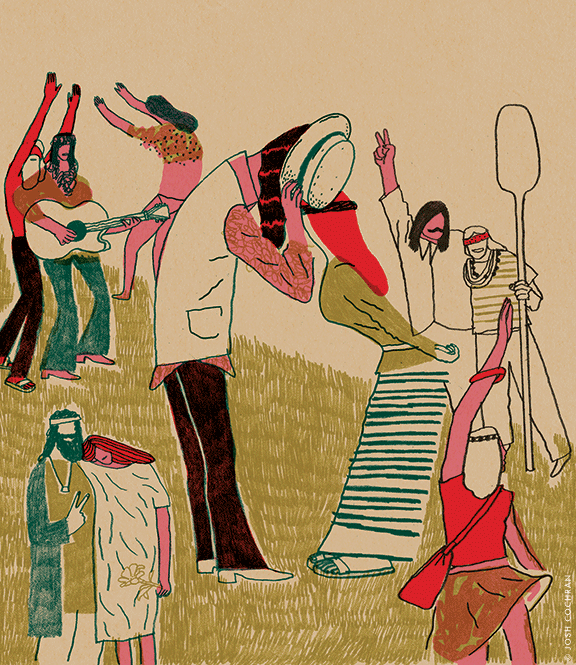
“There’s sex, and there’s drugs, and there’s rock n’ roll on the stage,” he says. “It was a mini-Woodstock in the spring of ’67 right there.”
Well, sort of. The drinking consisted of “mainly endless cans of beer,” and to the best of his recollection there were “not too many joints,” since “marijuana didn’t really hit the scene until the following fall.” But Marmon does remember “seeing several couples hooking up, as we would say today, right on the wet Franklin Field turf.”
That Skimmer weekend did set records for Penn student events: according to a DP story, nearly 3,000 students had filled Franklin field that Friday night to watch acts like Smokey Robinson and the Miracles, the Young Rascals, and the Chiffons. The weekend was packed with socializing and concerts for students, with “cocktail parties” on Saturday and Sunday mornings, and fraternity parties with more concerts Saturday night.
By this time Skimmer’s locus was shifting irretrievably away from the sporting event on the river. The DP’s Liz Yousem wrote that after Saturday morning’s cocktails, students walked to the Schuylkill for the “second show of the weekend with maybe a crew race or two thrown in.” A captioned picture of a cheerful group of students on blankets by the river claimed that close to “10,000 revelers (not all students) watched the crew races. At least that’s what they said they were doing.”
Unlike 1966, when men still had to wear jackets and ties to dinner, and women had to wear skirts in the library, recalls Marmon, “by the fall of ’68, spring of ’69, all of those rules—every one of them—was gone.” He remembers the introduction of drugs and new trends in music and art, the end of oppressive curfews and the introduction of pass/fail, brought forth by the newly formed SCUE, or Student Committee on Undergraduate Education.
Disc jockey and radio personality Carol Miller C’72, who got her start at WXPN, witnessed the beginnings of a transition to coed living as a female student living in Hill House. She remembers the lag between lax new rules for dorm life and changes in student behavior and culture. In some ways, she says, it was easier to navigate the intricacies of sexuality and consent when rules for visitation were still managed by the University.
“You hear about date rape and all that stuff on campus [today],” she says. “Believe me, it was going on. But when you had to go back to the dorm [for a curfew], it was pretty easy to get out of a date you didn’t want to be in.”
Speaking of changing mores, Marmon remembers what may have been “the last ‘true’ Rowbottom,” which took place during his sophomore year. One night a group of men living in the Quad stormed Hill House, then a women’s dormitory, intending to demand a ransom of intimate clothing. To their surprise, the hall’s administrators had prepared for the intrusion by organizing a mixer, which he recalls as very nice, “but not what we expected.”
By 1971, Skimmer had nearly run its course, morphing from a free-form and sometimes violent celebration of crew races into a campus-based weekend of music, drugs, drinking, and frat parties. A large portion of the undergraduate body considered itself too hip to attend, preferring to celebrate the weekend holed up in apartments and West Philly houses for private gatherings.
Nick Spitzer C’72, another ’XPNer who is now the public-radio producer of American Routes and an anthropology professor at Tulane University [“Digging Routes,” Mar|Apr 2009], remembers Penn’s own Edison Electric opening for the Youngbloods at Irvine Auditorium and doing a “very rocked-out version of ‘Drink a Highball’”—which they dedicated to Glee Club Director Bruce Montgomery before launching into their biggest song, “Ship of the Future.”
As Skimmer drifted inexorably into the past, the energy once reserved for Rowbottoms and raucous crew-team cheers flowed into student movements and protests, sit-ins and be-ins, student government petitions and defiant, symbolic burnings of draft cards and matriculation cards. If Skimmer was a remnant of an old Penn, an old boys’ club that preached decorum while practicing otherwise, then its demise was a final stamping out of the life that students were supposed to lead. With the end of Skimmer, that generation of students bid goodbye to the people they were supposed to become and the society that they were supposed to enter with pride.
“By that time, the alternative was very big,” says Ira Harkavy C’70 Gr’79, then a leader of student movements against the Vietnam War and other societal ills, now associate vice president and founding director of Penn’s Barbara and Edward Netter Center for Community Partnerships.
Harkavy and his friends were more concerned with events reaching beyond campus; like most undergraduate men in those years, the stomach-churning possibility of being drafted to fight in Vietnam was never far from his mind. Marmon remembers Harkavy giving a passionate speech in October 1969 urging the University to lower its American flags to half-mast in honor of Vietnam War dead, a motion that the student government passed after some controversy—culminating in then-sophomore Dorian Dale C’72 burning his matriculation card during the student government’s plenum. That motion acknowledged the fear of the draft and antipathy toward the war that so many undergraduate men had—so much so, according to Marmon, that a hugely disproportionate number were applying to the Graduate School of Education in hopes of earning a deferment.
Meanwhile, students like Dale were organizing around issues that were new in the national consciousness, like preserving the environment and curbing pollution. Dale helped plan and facilitate the first national Earth Day event in 1970, for which Penn became the unofficial headquarters. Penn’s event, which spread out over an entire week and into Fairmount Park, included speakers like US Senator Edmund Muskie, activist Ralph Nader, the Native American band Redbone, the cast of “Hair,” and the popular philosopher Alan Watts. As the undergraduate representative to the board of directors, Dale planned the event with a mix of Penn graduate students and professors, planners outside the University, and corporate representatives like General Electric.
By then, “Skimmer was increasingly in erosion alongside the cultural and environmental explosion at Penn and nationwide on college campuses,” says Spitzer. “It’s just that the Penn community was in the forefront, and the landscape of grand old gray, fading, and then re-greening Philadelphia was its canvas.” He remembers a string quartet playing an electrifying anti-war piece titled “The Dark Angels” by Penn music professor George Crumb Hon’09, intergalactic jazz by Sun Ra and his Arkestra, Philly soul bands and street preachers—and a “wide range of people speechifying, dancing, or tripping. It was a serious delirium of possibility!”
The following year Skimmer included “the annual Phineas T. Rowbottom Sports Car Rallye,” according to the April 23, 1971 issue of the DP. The event featured the Steve Miller Band and It’s A Beautiful Day. But in that year’s The Record, the undergraduate yearbook, a number of seniors confessed that they had already stopped attending.
On a rainy Sunday in February 1973, Craig Salvay C’74 stopped by the Bodine dorm room of his friends Bobbie Haft W’74 and Dave Dibo W’75. The two had an idea for a spring arts festival, which they proceeded to run by Salvay.
“We all agreed that Skimmer Weekend—its car rally, boat races, and other accouterments—had lost its relevance,” Salvay recalls. A new spring celebration was needed, one that involved food, music, and art; it would reflect “neither a particular tradition nor follow any pattern.” He thinks it was probably Haft who came up with the name Spring Fling and the first logo: an outline of Matisse’s La Danse. Haft also assembled an “array of two- and three-dimensional artists” from Penn and the Philadelphia area, says Salvay, while Dibo handled the food, the linchpin for which was a vendor named Al, the Fruit Man. Salvay took charge of the music, and brought together acts ranging from folk and folk-rock to hard rock and heavy metal—even a square dance in the Lower Quad led by Bates McClain.
Despite a total budget of $873—all contributed by students, mostly Haft, Dibo, and Salvay—that first Fling was a success. Others took over after that, and the rest of the decade saw an exponential rise in student participation, to the point where Fling became one of the most popular events of the year.
Though the term Rowbottom may have gone out of vogue, alcohol-fueled property damage and violence were still an issue. In 1988, students stampeded, stole performance equipment, and trashed two men’s bathrooms in the Quad, causing $7,000 worth of damage, according to the DP. The fête was tenuously allowed to continue, with the significant loss taken from the planning committee’s budget.
As the student body became more varied and diverse, divisions in participation grew along racial lines. For its first three decades, Fling (which usually featured alternative rock) overlapped with the Penn Relays concert, which drew more students of color and became associated with hip-hop; in 1981, black students protested the funding inequities that accompanied those divisions. In 2004, Penn’s Social Planning and Events Committee to Represent Undergraduate Minorities (SPEC-TRUM), had to decide whether to move the location or the date of the Relays concert, featuring Kanye West, because the required security personnel could not be provided to both that concert and Fling. The group first moved the event off campus, then returned it to campus on a different weekend.
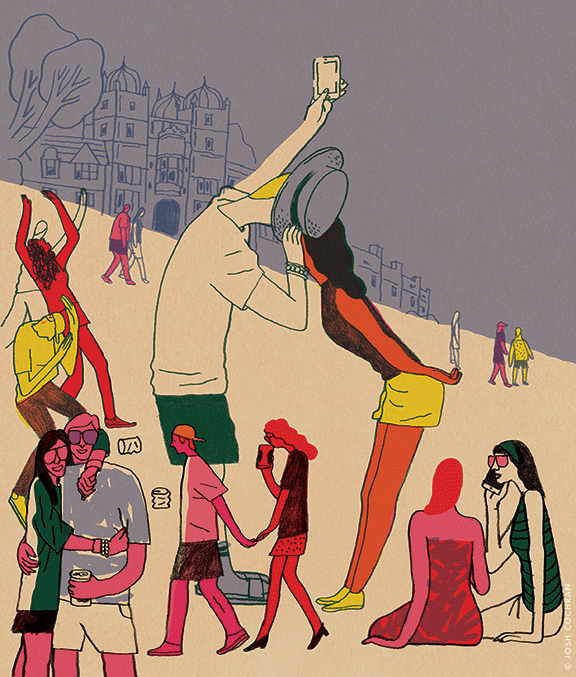
Over the years Fling has become an increasingly anticipated campus event, and according to senior Lauren Ballester EAS’15, it’s “the highlight of the spring semester for a lot of people.” Noting that “people who never participate in Penn social life will participate in Fling,” she adds: “And people go hard. Very heavy drinking, lots of partying. People count down [the days leading up to it] and bring their friends from far and wide. It is a big deal.”
In the past several years, Fling concerts have featured Billboard-topping headliners in genres ranging from hip hop to alternative rock, including artists like John Legend C’99 Hon’14, Flo Rida, Wyclef Jean, Snoop Dogg, Ben Folds, Janelle Monae, David Guetta, Passion Pit, and Girl Talk. Fling weekends are packed with activities, from the Friday-night concert to carnival-style activities in the Quad on Saturday and concerts sponsored by SPEC throughout the weekend.
For some, the very size and alcohol-fueled scope make it something to be wary of. Ballester says that the atmosphere can lead to “a lot of misogyny, and rape culture.”
“Fling for me has always kind of represented a sad time, sort of like institutionally funded drunkenness and institutionally funded irresponsibility,” says Penny Jennewein C’14, who spent much of her time in college developing alternative ways to live and thrive. During her freshman year she co-founded the Penn Haven Housing Co-op, an off-campus cooperative house dedicated to social justice, which a couple of years ago was one of three groups to offer a cheaper, more diverse alternative to Fling and its Friday-night concert. That year, the Orthodox Jewish community at Penn provided a Sabbath-friendly alternative to the concert, while the United Minorities Council hosted a Celebration of Cultures. That alternative Fling “was really about building alternate culture,” she says, recalling things like “bike rides, drum circle, meditation.” A slight smirk accompanies the memory.
Perhaps Penn’s spring fest has undergone a revolution in the truest sense of the word : a 360-degree rotation from an alcohol-fueled opportunity for students to let out the stress of a long year’s work, into—much the same. The arrests and serious debauchery may have diminished, but the spirit lives on, while some students still prefer to skip the crowds and participate in alternative forms of revelry.
Skimmer itself has been revived and repositioned in the form of “Skimmer Fest.” The fusion of Skimmer and Fall Fest, held on College Green a few weeks into the fall semester, has offered such entertainment as hot-air balloon rides, a Dave Matthews cover band, and the Quaker Girls dance team. The idea is to get students fired up for a new season of Penn football and other sports. Go Quakers.
Violet Baron is a freelance writer living in Brooklyn.


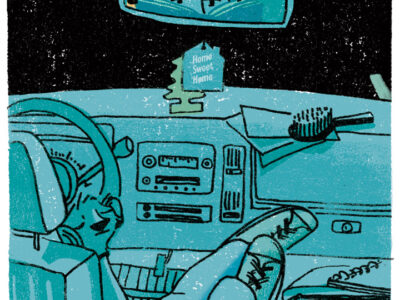
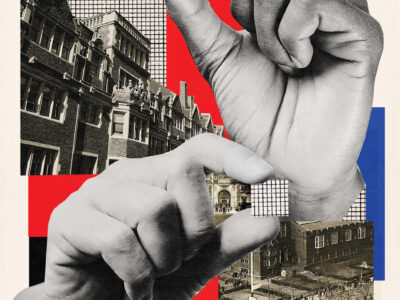

Bonnie Raitt -at Spring Fling 1977 -was AWESOME!